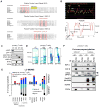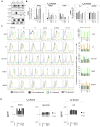Nuclear role of WASp in gene transcription is uncoupled from its ARP2/3-dependent cytoplasmic role in actin polymerization
- PMID: 24872192
- PMCID: PMC4137324
- DOI: 10.4049/jimmunol.1302923
Nuclear role of WASp in gene transcription is uncoupled from its ARP2/3-dependent cytoplasmic role in actin polymerization
Abstract
Defects in Wiskott-Aldrich Syndrome protein (WASp) underlie development of WAS, an X-linked immunodeficiency and autoimmunity disorder of childhood. Nucleation-promoting factors (NPFs) of the WASp family generate F-actin in the cytosol via the VCA (verprolin-homology, cofilin-homology, and acidic) domain and support RNA polymerase II-dependent transcription in the nucleus. Whether nuclear-WASp requires the integration of its actin-related protein (ARP)2/3-dependent cytoplasmic function to reprogram gene transcription, however, remains unresolved. Using the model of human TH cell differentiation, we find that WASp has a functional nuclear localizing and nuclear exit sequences, and accordingly, its effects on transcription are controlled mainly at the level of its nuclear entry and exit via the nuclear pore. Human WASp does not use its VCA-dependent, ARP2/3-driven, cytoplasmic effector mechanisms to support histone H3K4 methyltransferase activity in the nucleus of TH1-skewed cells. Accordingly, an isolated deficiency of nuclear-WASp is sufficient to impair the transcriptional reprogramming of TBX21 and IFNG promoters in TH1-skewed cells, whereas an isolated deficiency of cytosolic-WASp does not impair this process. In contrast, nuclear presence of WASp in TH2-skewed cells is small, and its loss does not impair transcriptional reprogramming of GATA3 and IL4 promoters. Our study unveils an ARP2/3:VCA-independent function of nuclear-WASp in TH1 gene activation that is uncoupled from its cytoplasmic role in actin polymerization.
Conflict of interest statement
Figures





Similar articles
-
Critical requirement for the Wiskott-Aldrich syndrome protein in Th2 effector function.Blood. 2010 Apr 29;115(17):3498-507. doi: 10.1182/blood-2009-07-235754. Epub 2009 Dec 23. Blood. 2010. PMID: 20032499 Free PMC article.
-
Nuclear role of WASp in the pathogenesis of dysregulated TH1 immunity in human Wiskott-Aldrich syndrome.Sci Transl Med. 2010 Jun 23;2(37):37ra44. doi: 10.1126/scitranslmed.3000813. Sci Transl Med. 2010. PMID: 20574068 Free PMC article.
-
Identification of another actin-related protein (Arp) 2/3 complex binding site in neural Wiskott-Aldrich syndrome protein (N-WASP) that complements actin polymerization induced by the Arp2/3 complex activating (VCA) domain of N-WASP.J Biol Chem. 2001 Aug 31;276(35):33175-80. doi: 10.1074/jbc.M102866200. Epub 2001 Jun 29. J Biol Chem. 2001. PMID: 11432863
-
The role of WASp in T cells and B cells.Cell Immunol. 2019 Jul;341:103919. doi: 10.1016/j.cellimm.2019.04.007. Epub 2019 Apr 17. Cell Immunol. 2019. PMID: 31047647 Review.
-
New insights into the regulation and cellular functions of the ARP2/3 complex.Nat Rev Mol Cell Biol. 2013 Jan;14(1):7-12. doi: 10.1038/nrm3492. Epub 2012 Dec 5. Nat Rev Mol Cell Biol. 2013. PMID: 23212475 Review.
Cited by
-
Signal Integration during T Lymphocyte Activation and Function: Lessons from the Wiskott-Aldrich Syndrome.Front Immunol. 2015 Feb 9;6:47. doi: 10.3389/fimmu.2015.00047. eCollection 2015. Front Immunol. 2015. PMID: 25709608 Free PMC article. Review.
-
DOCK8-expressing T follicular helper cells newly generated beyond self-organized criticality cause systemic lupus erythematosus.iScience. 2021 Dec 2;25(1):103537. doi: 10.1016/j.isci.2021.103537. eCollection 2022 Jan 21. iScience. 2021. PMID: 34977502 Free PMC article.
-
UNC-45A Is a Nonmuscle Myosin IIA Chaperone Required for NK Cell Cytotoxicity via Control of Lytic Granule Secretion.J Immunol. 2015 Nov 15;195(10):4760-70. doi: 10.4049/jimmunol.1500979. Epub 2015 Oct 5. J Immunol. 2015. PMID: 26438524 Free PMC article.
-
Lamin Dysfunction Mediates Neurodegeneration in Tauopathies.Curr Biol. 2016 Jan 11;26(1):129-36. doi: 10.1016/j.cub.2015.11.039. Epub 2015 Dec 24. Curr Biol. 2016. PMID: 26725200 Free PMC article.
-
Journey to the Center of the Cell: Cytoplasmic and Nuclear Actin in Immune Cell Functions.Front Cell Dev Biol. 2021 Aug 5;9:682294. doi: 10.3389/fcell.2021.682294. eCollection 2021. Front Cell Dev Biol. 2021. PMID: 34422807 Free PMC article. Review.
References
-
- Imai K, Morio T, Zhu Y, Jin Y, Itoh S, Kajiwara M, Yata J, Mizutani S, Ochs HD, Nonoyama S. Clinical course of patients with WASP gene mutations. Blood. 2004;103:456–464. - PubMed
-
- Thrasher AJ, Burns SO. WASP: a key immunological multitasker. Nat Rev Immunol. 2010;10:182–192. - PubMed
-
- Higgs HN, Pollard TD. Regulation of actin filament network formation through ARP2/3 complex: activation by a diverse array of proteins. Annu Rev Biochem. 2001;70:649–676. - PubMed
Publication types
MeSH terms
Substances
Grants and funding
LinkOut - more resources
Full Text Sources
Other Literature Sources
Miscellaneous

